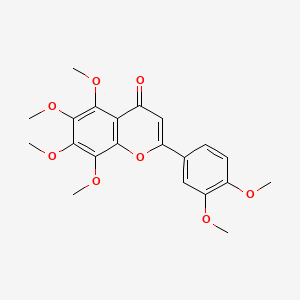
|
Nobiletin |
Nobiletin is a lipid of Polyketides (PK) class. Nobiletin is associated with abnormalities such as Hashimoto Disease, nervous system disorder, Dermatitis, Senile Plaques and Metabolic Diseases. The involved functions are known as 5-(carboxyamino)imidazole ribonucleotide mutase activity, Signal Transduction, Biochemical Pathway, Phosphorylation and MAP kinase kinase activity. Nobiletin often locates in Extracellular, Protoplasm, Back, Mouse Skin and Skin - Epidermis (MMHCC). The associated genes with Nobiletin are MAP2K1 gene, PTGS2 gene, Amyloid beta-Protein Precursor, Candidate Disease Gene and BCL2 gene. The related lipids are Lipopolysaccharides and Sterols. The related experimental models are Mouse Model and Transgenic Model. |
550 |

|
Glycitein |
Glycitein is a lipid of Polyketides (PK) class. Glycitein is associated with abnormalities such as PARAGANGLIOMAS 2, Osteoporosis, Cardiovascular Diseases, PARAGANGLIOMAS 3 and Intestinal Diseases. The involved functions are known as Transcription, Genetic, Regulation, luciferase activity, 5-(carboxyamino)imidazole ribonucleotide mutase activity and Transcriptional Activation. Glycitein often locates in Protoplasm, Cell Nucleus, Body tissue, Membrane and Entire bony skeleton. The associated genes with Glycitein are Genes, Reporter, Genome, Chromatin, JUN gene and G-substrate. The related lipids are Promega, enterodiol, saturated fat and Steroids. |
505 |
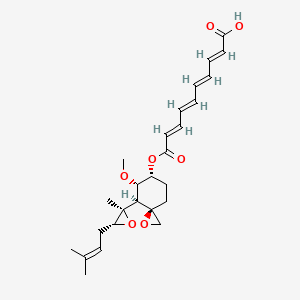
|
fumagillin |
Fumagillin is a lipid of Prenol Lipids (PR) class. Fumagillin is associated with abnormalities such as Atherosclerosis, Dentatorubral-Pallidoluysian Atrophy, Severe Combined Immunodeficiency, Immunologic Deficiency Syndromes and Arthritis. The involved functions are known as Gene Expression, Apoptosis, Angiogenic Process, Infiltration and Adverse effects. Fumagillin often locates in Endothelium, Body tissue, Blood, soluble and Protoplasm. The associated genes with fumagillin are HIST1H1C gene, RAC1 gene, c-myb Genes, METAP2 gene and NCKIPSD gene. The related lipids are helvolic acid, Butyrates and Butanols. The related experimental models are Mouse Model, Xenograft Model and Cancer Model. |
500 |
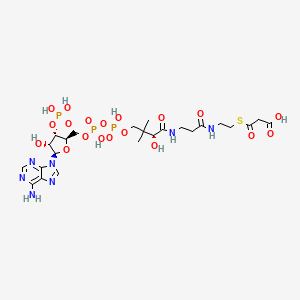
|
Malonyl-coa |
|
492 |
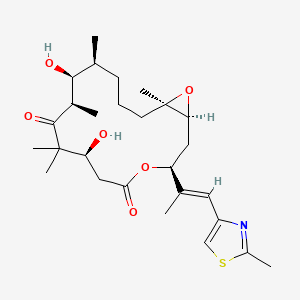
|
Epothilone B |
Epothilone B is a lipid of Polyketides (PK) class. Epothilone b is associated with abnormalities such as Myelosuppression, Measurable Disease, Neuropathy, Neutropenia and Thrombocytopenia. The involved functions are known as Cell Cycle Arrest, Apoptosis, Signal Transduction, Cytokinesis and Caspase Activation. Epothilone b often locates in Mitochondria, Cytoplasmic matrix, Microtubules, Spindle and Protoplasm. The associated genes with Epothilone B are TNFSF10 gene, DIABLO gene, FADD gene, BCL2 gene and BCL2L1 gene. The related lipids are Promega and Phosphatidylserines. The related experimental models are Xenograft Model and Mouse Model. |
492 |
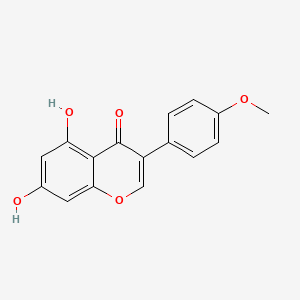
|
biochanin A |
Biochanin a is a lipid of Polyketides (PK) class. Biochanin a is associated with abnormalities such as Osteoporosis. The involved functions are known as Uptake, adenosinetriphosphatase activity, inhibitors, Drug Interactions and Metabolic Inhibition. Biochanin a often locates in Membrane, Tissue membrane, Microsomes, Microsomes, Liver and Entire oral cavity. The associated genes with Biochanin A are CD9 gene, SLCO1B1 gene, ABCG2 gene, EDNRB gene and SPAG8 gene. The related lipids are Steroids, Androstenols, Sphingolipids and 1,2-oleoylphosphatidylcholine. |
465 |
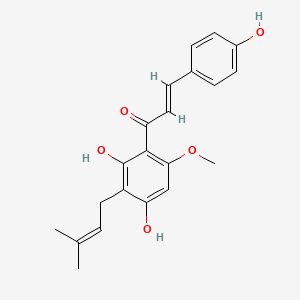
|
Xanthohumol |
Xanthohumol is a lipid of Polyketides (PK) class. Xanthohumol is associated with abnormalities such as Endometriosis, site unspecified, Cyst, peritoneal lesion, Proliferative inflammation and furuncle. The involved functions are known as Cell Proliferation, Signal Transduction, Pathologic Neovascularization, Adverse effects and Proliferation (morphologic abnormality). Xanthohumol often locates in peritoneal, Mesentery, Membrane, Tissue specimen from uterus and Cell Nucleus. The associated genes with Xanthohumol are PI3 gene, KEAP1 gene, SLC33A1 gene, BCR-ABL Fusion Gene and BIRC5 gene. The related lipids are Fatty Acids and Palmitates. The related experimental models are Knock-out. |
465 |
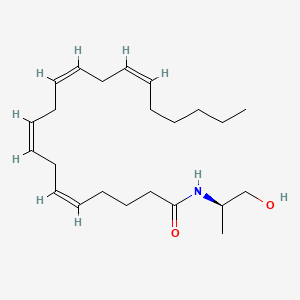
|
N-(1R-methyl-2-hydroxy-ethyl) arachidonoyl amine |
N-(1r-methyl-2-hydroxy-ethyl) arachidonoyl amine is a lipid of Fatty Acyls (FA) class. |
457 |
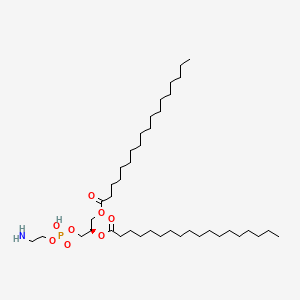
|
1,2-Distearoyl-sn-glycero-3-phosphoethanolamine |
1,2-Distearoyl-sn-glycero-3-phosphoethanolamine is a lipid of Glycerophospholipids (GP) class. 1,2-distearoyl-sn-glycero-3-phosphoethanolamine is associated with abnormalities such as Painful Bladder Syndrome, Dehydration, Renal tubular disorder, Gigantism and Tumor-Associated Vasculature. The involved functions are known as conjugation, Ligand Binding, Process, Laser-generated electromagnetic radiation and Blood Circulation. 1,2-distearoyl-sn-glycero-3-phosphoethanolamine often locates in Tissue membrane, Early endosome, Body tissue, Cell surface and Membrane. The associated genes with 1,2-Distearoyl-sn-glycero-3-phosphoethanolamine are R peptide, P4HTM gene, NHS gene, TSPO gene and SLC33A1 gene. The related lipids are Liposomes, 1,2-distearoylphosphatidylethanolamine, Micelles, Fatty Acids and sialogangliosides. |
438 |
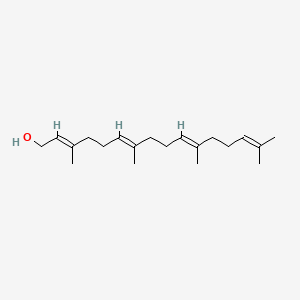
|
Geranylgeraniol |
Geranylgeraniol is a lipid of Prenol Lipids (PR) class. Geranylgeraniol is associated with abnormalities such as abnormal fragmented structure, Hyperostosis, Diffuse Idiopathic Skeletal and Tuberculosis. The involved functions are known as Positive Regulation of Apoptosis, Anabolism, Prenylation, Apoptosis and pathologic cytolysis. Geranylgeraniol often locates in Body tissue, Cytoplasmic matrix, Red Cell Ghost, Spindle and Nuclear lamin. The associated genes with Geranylgeraniol are MST1 gene, STN gene, UMOD gene, ABCA1 gene and RHOA gene. The related lipids are Sterols, Hydroxycholesterols, SK&F 104976 and 25-hydroxycholesterol. |
403 |
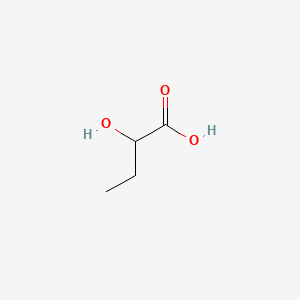
|
(+/-)alpha-hydoxy butyric acid |
(+/-)alpha-hydoxy butyric acid is a lipid of Fatty Acyls (FA) class. |
390 |
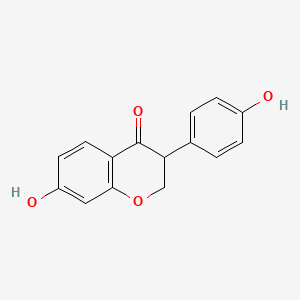
|
dihydrodaidzein |
dihydrodaidzein is a lipid of Polyketides (PK) class. Dihydrodaidzein is associated with abnormalities such as Bacteremia, Little's Disease and Postmenopausal syndrome. The involved functions are known as Metabolic Process, Cellular, racemization, Cytokinesis, enzyme mechanism and Stereochemistry. Dihydrodaidzein often locates in Cell-Free System, Face, Blood, Back and Cytoplasm. The associated genes with dihydrodaidzein are HOXA10 gene and tryptones. The related lipids are enterodiol. |
338 |

|
(-)-Perillyl alcohol |
(-)-perillyl alcohol is a lipid of Prenol Lipids (PR) class. The involved functions are known as Cell Cycle Progression, Cell Cycle, Cell Proliferation, Apoptosis and Isoprenylation. (-)-perillyl alcohol often locates in Cytoplasm, Membrane and Plasma membrane. The associated genes with (-)-Perillyl alcohol are JUN gene, Candidate Disease Gene, IL24 gene, BCL2L1 gene and CFB gene. The related experimental models are Transgenic Model. |
299 |
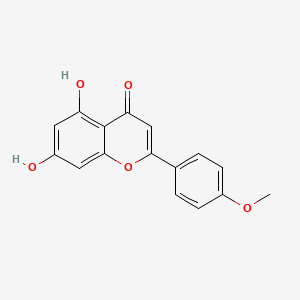
|
acacetin |
acacetin is a lipid of Polyketides (PK) class. Acacetin is associated with abnormalities such as Cardiovascular Diseases, Janiceps and Meralgia paresthetica. The involved functions are known as Cell Cycle Arrest, Cell Growth, Agent, Metabolic Inhibition and Cell Death. Acacetin often locates in Protoplasm, Membrane, Plasma membrane, Capillary blood and Endothelium. The associated genes with acacetin are CDKN1B gene, KCNH2 gene, MSMP gene, COX8A gene and PI3 gene. The related lipids are Lipopolysaccharides. The related experimental models are Xenograft Model. |
277 |
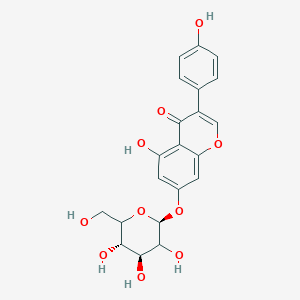
|
genistein 7-O-glucoside |
genistein 7-O-glucoside is a lipid of Polyketides (PK) class. Genistein 7-o-glucoside is associated with abnormalities such as athymia, Heart Diseases, Thyroid Diseases, Plague and Brucella infections. The involved functions are known as Cell Proliferation, Binding (Molecular Function), Ingestion, topoisomerase activity and kinase activity. Genistein 7-o-glucoside often locates in Membrane, Gastrointestinal tract structure, Oral region, Body tissue and Blood. The associated genes with genistein 7-O-glucoside are GLUCOSIDASE, PPP1R1A gene, Homologous Gene, Genome and FUSE gene. The related lipids are Sterols, 1,2-oleoylphosphatidylcholine, Membrane Lipids and DOPE. |
264 |
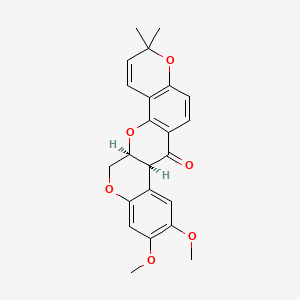
|
Deguelin |
Deguelin is a lipid of Polyketides (PK) class. Deguelin is associated with abnormalities such as Hypertensive disease, Parkinson Disease and athymia. The involved functions are known as inhibitors, Drug Interactions, ATP binding, Down-Regulation and Angiogenesis. Deguelin often locates in Endothelium, Vascular and Body tissue. The associated genes with Deguelin are MAP2K1 gene. |
246 |
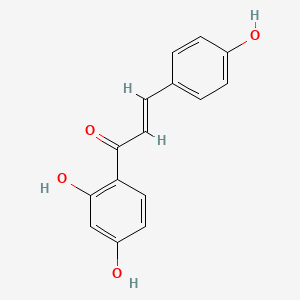
|
isoliquiritigenin |
Isoliquiritigenin is a lipid of Polyketides (PK) class. Isoliquiritigenin is associated with abnormalities such as abnormal fragmented structure, Gastric ulcer, Gastric mucosa lesion, Peptic Ulcer and Wiskott-Aldrich Syndrome. The involved functions are known as Mass-to-Charge Ratio, Anabolism, Oxidation, inhibitors and Energy Absorption. Isoliquiritigenin often locates in Microsomes, Liver, Hepatic, Microsomes, Immune system and Vacuole. The associated genes with Isoliquiritigenin are P4HTM gene, BCL2 gene, AP1AR gene, oxytocin, 1-desamino-(O-Et-Tyr)(2)- and ODAM gene. The related experimental models are Knock-out. |
220 |
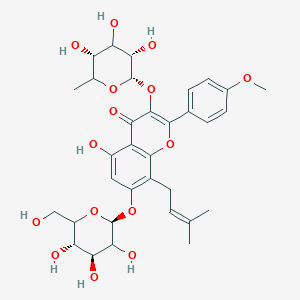
|
LMPK12112009 |
LMPK12112009 is a lipid of Polyketides (PK) class. |
216 |
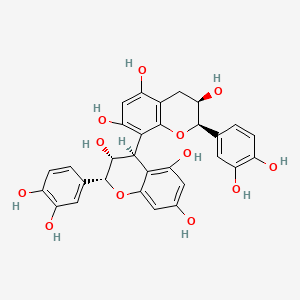
|
Procyanidin B2 |
Procyanidin B2 is a lipid of Polyketides (PK) class. The involved functions are known as conjugation, Methylation, Excretory function, enzyme activity and sulfatase activity. Procyanidin b2 often locates in Blood, Epidermis and Upper Gastrointestinal Tract. The associated genes with Procyanidin B2 are NR5A2 gene, HRAS wt Allele, CFB gene, PTGS2 gene and MAPK8 gene. |
205 |

|
butein |
Butein is a lipid of Polyketides (PK) class. Butein is associated with abnormalities such as Glomerulonephritis, Fibrosis, Liver, Kidney Failure, Acute, Mastocytosis and Chimera disorder. The involved functions are known as Phosphorylation, Transcription, Genetic, IkappaB kinase activity, Gene Expression and Signal Transduction. Butein often locates in Membrane, Cytoplasmic, IkappaB kinase complex, Protoplasm and Plasma membrane. The associated genes with Butein are ICAM1 gene, MAPK8 gene, MYC gene, BCL2 gene and BCL2L1 gene. The related lipids are Promega. The related experimental models are Xenograft Model, Knock-out and Mouse Model. |
190 |



















